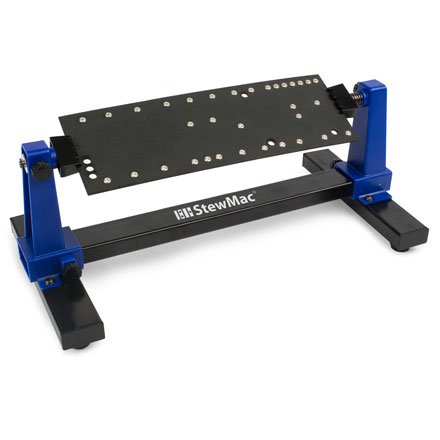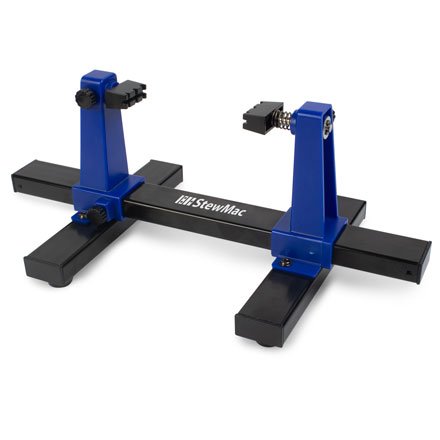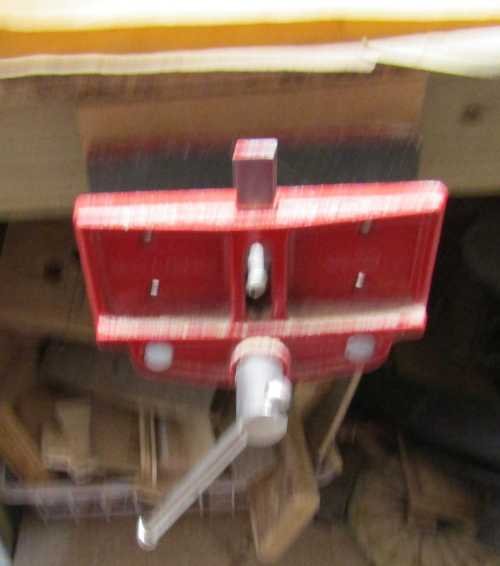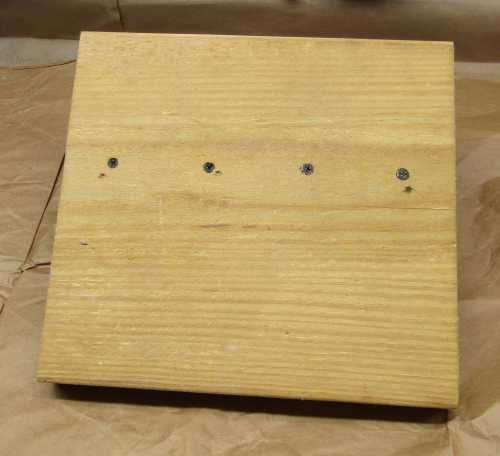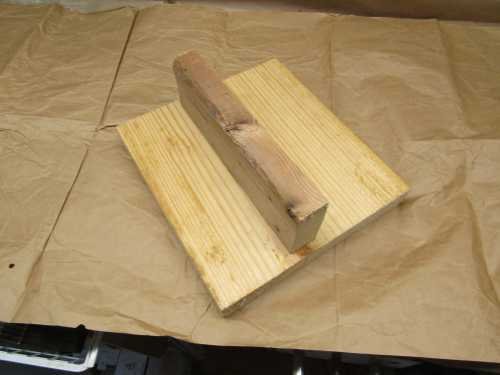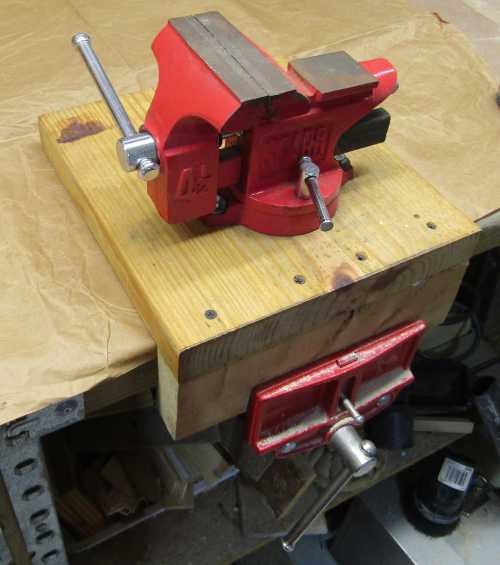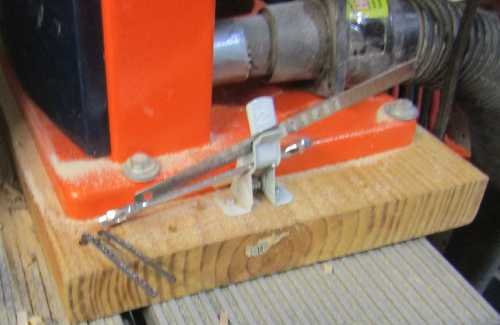-
Posts
3,084 -
Joined
-
Last visited
Content Type
Profiles
Forums
Gallery
Events
Everything posted by Jaager
-

Converting a Backyard Shed into a Model Workshop
Jaager replied to Hank's topic in Modeling tools and Workshop Equipment
Hank, Before you get too far along, You could consider adding a caboose to your "shack". With a 2 1/4" to 4" pipe and 110V communication thru the wall and a couple or three layers of sound batting on the common wall. The weather proof add-on would house a vac. You could keep a Dust Devil type cyclone trap in the main room and move it from machine to machine. The 110V is easily controlled using an RIF remote clicker. Go for quality with the radio control box - saves buying one twice. This way your ears will not be assaulted by the vac, the discharge is to the outside world and you can listen to music while generating saw dust. It would also maybe work with a paint spray booth. With the cyclone trap in the main room, you will not need to attend to catch basin or filter on the main vac all that often. -
For solid hulls and masts - before the deck is laid - an oversize hole that covers the rake angle zone and approaches the depth to the top of the keelson. Then, after the deck is laid - a spike ( the cut off point of a ten penny nail ) at the heel of the mast will secure the bottom and functioning mast wedges can fine tune the rake. Other holes, a collection of pin vises and something like a Dremel 8050 (needs additional collets)
-
JD, If the wood is invaded by Blue Mold and is grey or blue, it should be just as sound as normal Holly. It is similar in hardness to Black Cherry, so it is not rock hard. If you can dent it using significant pressure, but does not crumble, you are golden. It takes dyes well, so the fungal stain is not one that you are stuck with. It is suitable for most every part of hull. It is reserved, because it is expensive and difficult to obtain. Commercial - the infected wood is seen as trash. If yours is grey, it may useful as is for bottom planking for pre-1770's hulls - before coppering - that were treated with light colored gunk. It can be affected by humidity changes, so I would shellac the hidden inside surfaces and use another species for spars. I would be greedy, be very, very greedy. Get as much as can be had. The Fates do not offer opportunities like this much more than once in a lifetime. If nothing else, it could be useful for sale or trade in the future. Unless stored using poor conditions, it will out last you.
-
It is possible to use a dye on the under the copper planking to match the color of the copper - especially the old penny end point. Using alcohol based dye will avoid the fiber swelling factor with aqueous dyes. Because it is hidden, the shallower depth with alcohol dyes is not a problem. This has no effect on the wood surface v.s. bare wood. I am not using slang, a dye is a totally different material from a stain. A stain is semi transparent wood colored paint. If your wood is quality, a dye offers options for display, without affecting the grain as viewed. A stain is to improve low quality wood. It muddies quality wood. A thought that repeats is why expend all this time and effort using low quality wood, unless it is to be painted?
-

Pin driver
Jaager replied to ErnieL's topic in Building, Framing, Planking and plating a ships hull and deck
This thread may add more insight for this topic: *https://modelshipworld.com/topic/23377-nail-drivers -
This is my opinion. I am not a professional in the paint industry or a professional cabinet maker. Do not take this as authoritative as it reads. It is just easier to use an imperative verb tense in this case. 1) Shellac is good to use as a primary coat before painting. Use 50:50 concentration as a first coat. It fills small pores, penetrates the wood, locks down the surface fibers and leaves a very thin addition to the surface. Steel wool 0000 ( be sure to remove all steel slivers or = rust/stain) or Scotch Brite leaves a smooth surface for paint and it saves a coat of paint. Copper plating .... which type, how is it to adhere to the hull. If it is adhesive backed foil, shellac may be a good surface. If it is metal/ glue - bare wood AND abrasive clean any copper oxidation layer from the back of the metal. If it is metal paint on bond paper, bare wood. 2) Primer can be dilute paint - shellac is a good base for any follow on - paint or clear. If by primer, you mean sand n sealer - this is mostly for open pore wood species - like Oak, Walnut, and the stuff in a lot of kits. It has particles of stuff like plaster to fill the pores and leave a smooth surface. If you have used a good choice of the species for the planking, it is superfluous. No pores to fill. Skip the shellac and you may need an additional coat of paint. Since you are not painting the interior walls of a house, the additional cost of another coat of paint is nill. 3) Tung oil is for a clear finish. Shellac can go first, or 50::50 Tung oil : mineral spirits. No point in using it over paint. Too much gloss on the paint itself is often already a problem with models: scale effect. Additional gloss from Tung oil would make this worse - unless it is a toy that you are displaying. 4) Tung oil is an oil. It stays wet until it polymerizes. It would be awful as a base for any type of copper plating. 5) Beats the -ell out of me, why anyone would want to. I sure would not go it.
-
JD, Billets are 1" to 2" thick sections of a small log. The width is whatever it turns out to be. Doing thin slices on wet wood is probably a good way to lose all of it. If you do not seal the transverse cut surfaces - the ones that cross cut the fibers (tubes) - more water will leave from the open tubes than thru the walls. The vastly uneven drying will produce severe checking. The wood will experience extensive splitting. Often along the total length. Minor checking at the cut ends is the norm no matter. But another coat of sealer may help. The last time I did this, I used left over enamel paint and a sheet of Bounty as an applicator. Latex gloves. no cleanup - it does drip, so do not do it over any unprotected surface that you care about. Removing the bark speeds drying. Some wood has wood eating insect eggs and larvae just under the bark. If they are present and not removed, the dry wood may be Swiss cheese. The pith in most wood is not useful. In some species it is spongy. It is also an origin for checking. Removing it may reduce splitting and increase the yield of usable wood. Even though I like the face of quarter sawn slices, I usually slice a billet with the blade going thru the pith. Was it Davis or Underhill who wrote about collecting branches after a wind storm and using the branch forks to get knees and hooks with naturally curved grain? I think species where the branching is close to 90 degrees are more useful than those with acute angles, but not all branching is bad. It is not good for billets, but those sections can be their own thing. A log wants to roll and has no even edge to ride against a fence. A carrier board that lays on the table with a straight edge for the fence..... the log can be fixed to and overhang the other edge of this carrier. I use right angle timber framing brackets to hold a log, Short pan head screws (1/2") for the carrier and long drywall screws to hold the log. The carrier is a bit of a problem with a table saw - it costs 1/2" depth per cut. With a large bandsaw - which is the tool for this - no problem. The problem with large logs is the maximum distance the fence can be from the blade. But in this situation, I do the dangerous thing and long axis bisect the log with the chain saw. This for sure removes the pith and a lot more. For what you have, this is not a factor at all.
-
If it was in the US, a problem with Blue Mold infection after cutting is about universal. It is a critical problem if you wish the wood to be snow white. Your var. may not be white to begin with, some are yellow. I was told here that Blue Mold is not as bad in the UK. But, I will proceed as though it were. Blue Mold discolors, but otherwise does not affect the usability of the wood. It is just robins egg blue or grey. To counter it, Holly is harvested in the Winter. The cut ends are sealed on site. Old house paint will work as well as anything. It is cut into billets and debarked as soon as possible. It is then immediately loaded into a kiln and stickered for drying. Holly is wet when freshly cut. As I was bandsawing an unsealed log, the blade was pushing water out of the end, I made my own "kiln". 1" foil faced foam insulating sheeting, 200W- 400W of incandescent light bulbs as the heat source. A DC muffin fan as a low cost water vapor exhaust. A thermometer (digital - holds the highest temp) make it too hot for the mold, but not much more. It will take a couple or three months. It is faster than air drying, which is 1 year/inch. Holly wants to twist as it drys. A lot of weight on top of the stack can counter this, but at our scale and volume of wood that is difficult. Not much works for us better than Holly. It is hard enough. holds an edge. bends well. takes well to wood dyes. Almost no grain or pores. I think the grey infected wood makes for a more realistic deck than white. Excellent for framing timber, but above miniature scales, this requires a volume of wood that is better supplied by easier to obtain species. Works well for beams, clamps, hooks, deck furniture, and especially planking. Dyed black, it stands in for Ebony, without the hassle of toxic and invasive wood flour. It should be worth the effort, despite the harvest challenge. Even if your stock winds up stained by the fungus, it will still be as suitable for our purposes as anything you can find.
-
My thinking on the situation is that the two important strakes for a successful bottom planking are the wale and the garboard. It is important that the garboard absorb the first part of the arc from the baseline horizontal at the bow and what it can of the excess at the sternpost rabbet ( or arc if double ended). All this while keeping its outer edge a straight line. Because of this, I propose that a sacrifice of economy was made and the garboard was often cut from a plank that was often up to twice the width of the other planking stock. In the spirit of pay me now, or pay me a lot more later. Given that the seam at the stem-keel-stern rabbets are at the intersection of two different planes of force/flex/stress and failure is difficult to repair, a dinky garboard could be a disaster.
-
Way back in literature from the 1960's and earlier, White Pine or pattern makers Pine was suggested as a preferred choice for carved hull - either solid or built up from layers. What with popularity of POB and the attempts to mitigate its major short coming by adding supporting fill material between the moulds, Pine is far superior to the odious Balsa in doing it. It does not need to be the more expensive White Pine. Select grade framing stock works as well. The problem is getting 2x4 or 1x4 stock into usable thicknesses. Basswood is also good for this There are two Tilia sp. that are commonly available. In North America it is Basswood. In Europe it is Lime (Linden). Lime has been long a favorite for architectural scale carving. It carves well and easily in large scale. It is about twice as hard as Basswood. Good characteristics are consistent texture, inconspicuous grain, and near invisible pores. White Pine also shares these characteristics. I find Basswood and White Pine to be too soft for ship construction. It is difficult to get sharp edges and hold them. It does not take much pressure to dent either species. Another species that you may find easy to source and be about the same cost is Yellow Poplar. It is soft and easy to work, but it holds an edge. The negative is that it is inconsistent in color in a small piece and can be ugly. If it is hidden inside or painted or stained, it is a good choice. I do not know how attractive a dyed piece is.
-

angle of attack of my blade
Jaager replied to agamemnon9's topic in Modeling tools and Workshop Equipment
Bob. How many bamboo sticks does it take to get a tight fit in the erasers socket? Duco will bind the bundle after a few minutes. -

angle of attack of my blade
Jaager replied to agamemnon9's topic in Modeling tools and Workshop Equipment
When you write 1mm, is that the thickness of the stock, or the width of the cut? Check the info here for a tutorial for the Byrnes saw and the recommended blade / teeth for a given thickness of stock. Perhaps a piece of wood on top and something like a GRR-Ripper? This may help keep fingers out of harms way. -
This tool was the subject of one of the almost daily email ads from StewMac. It appears to be sturdy, heavy, and adjustable. It is not especially expensive. In the spirit of finding a tool in search of a function, do we have jobs where this may be of use? Carving decorations, if you wish to sit up straighter, or off the ship rigging assembly?
-

Blades for byrnes table saw
Jaager replied to michael101's topic in Modeling tools and Workshop Equipment
Jim makes adapter bushings, call him and ask if a band that narrow is something he would do. Otherwise, tolerances that sloppy are probably a very bad idea. -
Way back when an IBM XT was cutting edge, there was an excellent program = Word Perfect that could search a document for all instances of a selected word. This sort of program has become more sophisticated and capable and OCR has also. In the posts where old school draftsmen are discussing a lost job type, I am musing that there may have been specialists, no longer needed, who assembled the index for technical books and articles. Were I an author, I am pretty sure it would be a deal breaker if I was required to formulate an index for my own work pre computer.
-
Uhhh John..... unless you like getting offers from African "princes" to collect lost bank accounts, if you just pony up earnest money or boner pill ads, you should maybe edit your email address out of your post, before the web crawlers find it. And you might want to establish a credible presence here before asking someone to supply you with a copy of copyrighted literature. I can't get that publisher to reply to an offer to buy plans used in Rif Winfield's books. The way they botched the Model Shipwright franchise, I doubt that they have the slightest clue about the value of what they have, so I would not bet on their being a reprint. It is like some suit has a grudge against the now retired editor, but they still own it.
-
Jorge, Here is the type of vise: The top of a work surface intended to be clamped by the vise: The bottom of the work surface with the tongue that fits into the vise: A mechanics vise bolted to a piece of 2x12 and clamped by the bench vise: The specific tools for my 9" bandsaw, placed to be at hand: The 6" steel ruler - I have several and they seem to hide if I do not detail them to a tool. The bandsaw is heavy enough not to need clamping so I removed the tongue.
-
As for steam bending, Holly is really good at this. Unless you have or have a relative with Holly to harvest, access to a kiln and can wait until Winter to cut down the trees, you will have to use the snow white commercial stock. For what you want to do, using store bought Holly would be a bit like making counterfeit pennies using Silver and spending it like a penny.
-
Ash is long lasting on land even if it is not very much protected. At least the shovel and mattock handles of tools I got from my contractor grandfather held up. They had spent time in the rain and sun. The summer wood was proud of the spring wood. Bare wood, they were not pretty, but they were plenty strong. For a display scale model, for any visible parts, Ash, Oak, Hickory have grain that is too stark and pores that are too large. If painted, an extra step using a sealer to fill the pores is needed if a smooth surface is a target. For structure hidden inside, these should work. For your purpose, I am thinking Ash should work just as you hope. The epoxy will take care of any out of scale grain or open pore characteristics, especially if you finish with paint and not clear coat.
-
Andy, When I get OCD, I prime end grain with 50:50 PVA:water. I blot any excess. It then is allowed at least 24 hrs to polymerize. It is for instances of end grain to end grain bonds. This is never a strong bond, but pre filling the open spaces with plastic could help. For planking - no dilution is needed or wanted. Use quality PVA. Titebond II has worked well for me. Use a damp rag or paper towel to remove any squeeze-out. I cannot think of any wood to wood bonding situation where dilution of PVA would have any advantage. I imagine only bad results from doing it. For natural fiber rigging that comes off the ropewalk, bookbinders neutral pH PVA diluted 50:50 is a treatment for the line while hanging under weights.
-
Hank, Keep him seriously bribed. Saw dust is messy but easy to clean up; and not critical if you miss some. Steel kerf and shavings are something else. They can play havoc with a machine. When a job is finished, a mill or lathe needs serious and time consuming disassembly, messy cleaning, and reassembly. Steel shavings are really unpleasant to deal with. And the oil...., I use laxative mineral oil for way oil, but it is still a chore to remove.
-

Santa Maria Painted Hull?
Jaager replied to Papa's topic in Building, Framing, Planking and plating a ships hull and deck
A shallow search indicates that Spain did not mine asphalt for another 200 years, so the pitch was probably "Pine" tar. Dark, but not 000,000,000 black. The proportions of dark brown and tallow are maybe lost forever or in the Spanish archives, but see what 50:50 dark brown to tan nets you. -

Adding Bulkheads
Jaager replied to acaron41120's topic in Building, Framing, Planking and plating a ships hull and deck
The tops of your moulds are sort of swinging in the breeze. Filling between them is a better idea than even with those models with a central spine that gets close to the deck beam level. See if there is a local wood workers guild. You can probably get more help with access to serious power tools than would be imagined. The alternative - a pack of Midwest Basswood sheets 1/4" and a smaller supply of 1/16" sheets. A fret saw should work. A good base helps. Here is examples of what I am discussing as stock: https://www.dickblick.com/items/33300-9412/ https://www.dickblick.com/items/33300-9602/
About us
Modelshipworld - Advancing Ship Modeling through Research
SSL Secured
Your security is important for us so this Website is SSL-Secured
NRG Mailing Address
Nautical Research Guild
237 South Lincoln Street
Westmont IL, 60559-1917
Model Ship World ® and the MSW logo are Registered Trademarks, and belong to the Nautical Research Guild (United States Patent and Trademark Office: No. 6,929,264 & No. 6,929,274, registered Dec. 20, 2022)
Helpful Links
About the NRG
If you enjoy building ship models that are historically accurate as well as beautiful, then The Nautical Research Guild (NRG) is just right for you.
The Guild is a non-profit educational organization whose mission is to “Advance Ship Modeling Through Research”. We provide support to our members in their efforts to raise the quality of their model ships.
The Nautical Research Guild has published our world-renowned quarterly magazine, The Nautical Research Journal, since 1955. The pages of the Journal are full of articles by accomplished ship modelers who show you how they create those exquisite details on their models, and by maritime historians who show you the correct details to build. The Journal is available in both print and digital editions. Go to the NRG web site (www.thenrg.org) to download a complimentary digital copy of the Journal. The NRG also publishes plan sets, books and compilations of back issues of the Journal and the former Ships in Scale and Model Ship Builder magazines.



